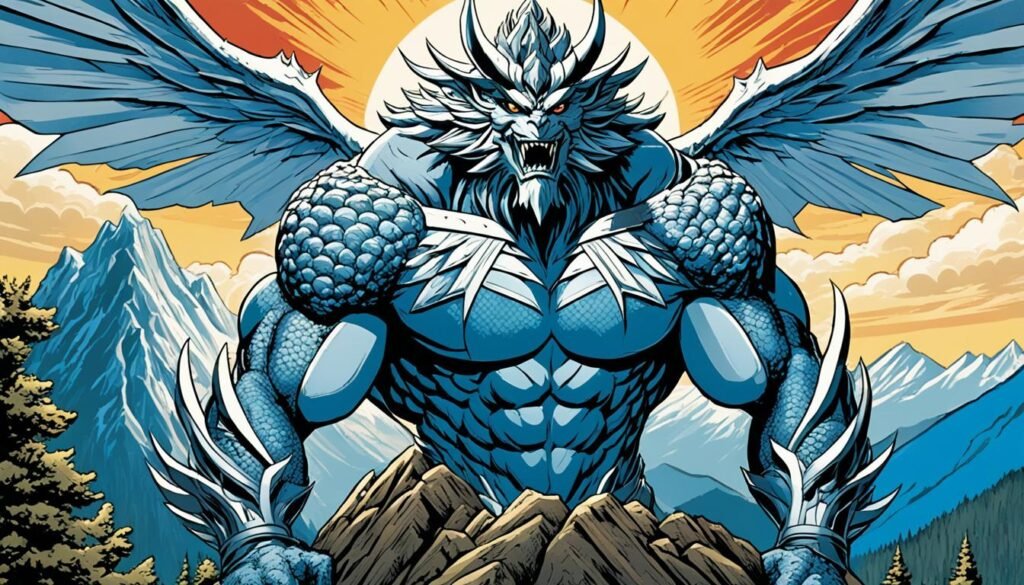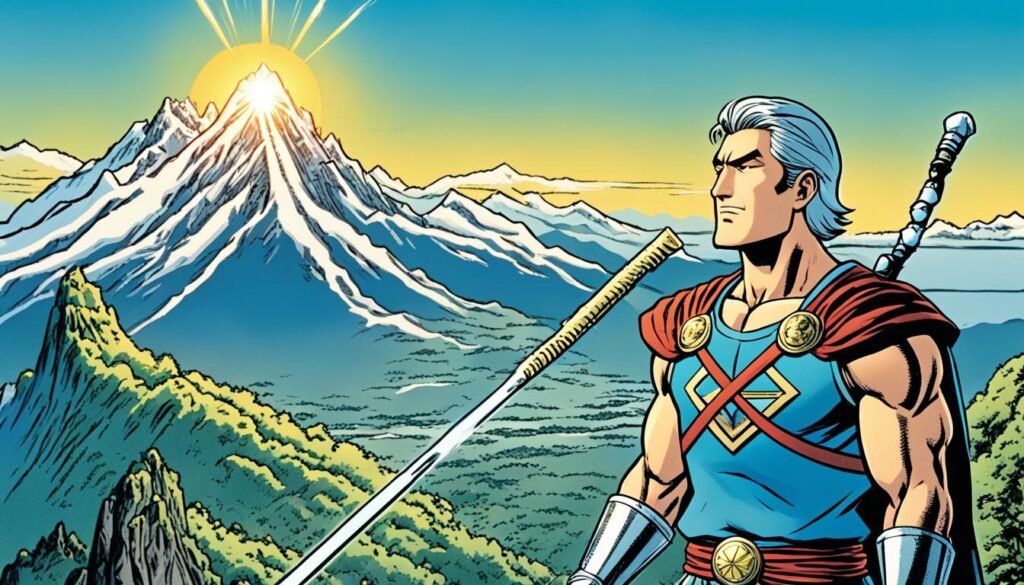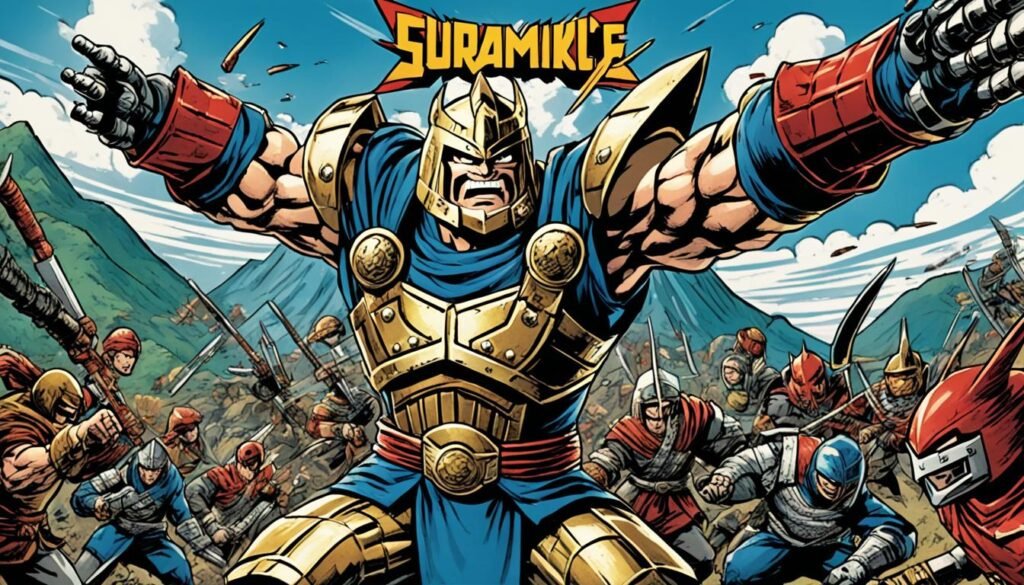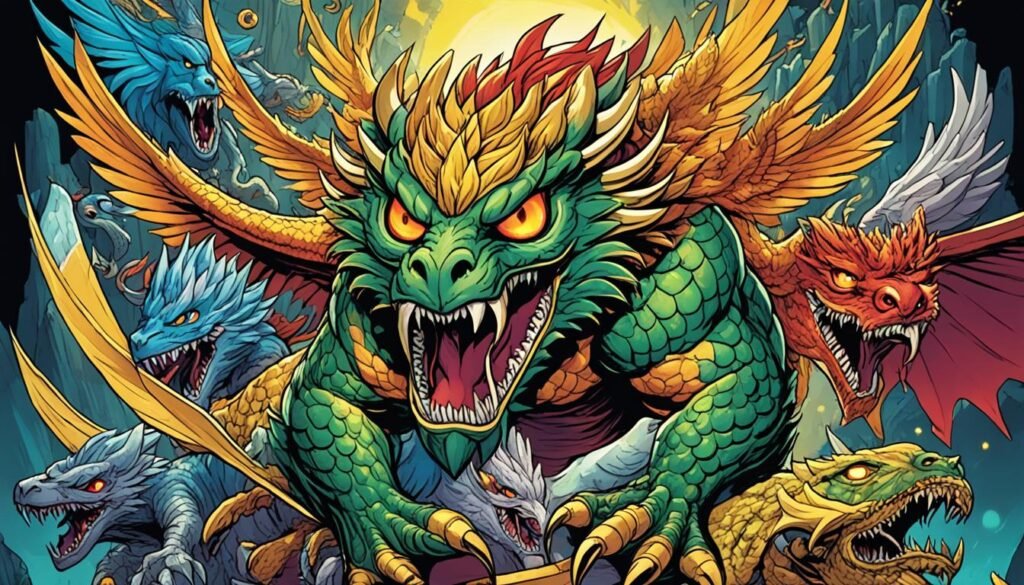At the top of Mount Kabalalan, a mythical figure watches over the land. It demands both respect and fear from those nearby. Kurita is the name of this powerful creature, known in Philippine mythology. The tale of Kurita is an important part of the country’s culture, showing the lasting influence of its myths.
In my early days, I heard about Kurita’s legend. It was said to be huge and protected Mount Kabalalan’s beauty. These stories showed Kurita as the heart of Philippine folklore, as a powerful guardian revered by all.
As I learn more about Philippine mythology, Kurita’s story intrigues me. It highlights the strong impact of these stories on Filipino culture. Let’s explore the tale of Kurita, the protector of Mount Kabalalan, and understand its deep meaning within Filipino folklore.
Key Takeaways
- Kurita is a legendary figure revered as the Guardian of Mount Kabalalan in Philippine mythology.
- The myth of Kurita is deeply rooted in the rich cultural heritage and belief systems of diverse ethnic groups across the Philippines.
- Kurita embodies the spirit of the natural wonders found within the country, representing the power and mystery of the natural world.
- The legend of Kurita has been passed down through generations, shaping the cultural identity and folklore of the Filipino people.
- The story of Kurita continues to captivate and inspire, showcasing the enduring significance of Philippine mythology in the modern era.
Introduction to Philippine Mythology
Philippine mythology is full of mythological beings and creatures. These stories are important to over 140 ethnic groups across the country. Each group tells tales of unique deities, spirits, and protectors. These mythological creatures are key to Filipino culture and folklore.
Overview of Philippine Folk Beliefs
In the Philippines, mythological creatures are vital to people’s lives. These beings serve as guardians and symbols of nature. People deeply respect them, and their stories are passed from one generation to the next. This sharing helps keep Filipino traditions and values alive.
Significance of Mythological Creatures
The Philippines has a wealth of mythological figures. Each ethnic group contributes to a rich tapestry of deities and spirits. The diversity reflects the country’s deep cultural heritage. Philippine mythology is a key part of the nation’s identity and culture.
Diversity of Ethnic Groups and Pantheons
Philippine mythological creatures mirror the vast diversity of its people. Figures like the Aswang, Duwende, Engkanto, and Higante paint a rich picture. This diverse mythological landscape shows the country’s lively indigenous beliefs.
The Legend of Kurita
Origin of the Myth
The legend of Kurita, known as the Guardian of Mount Kabalalan, is a key part of Philippine mythology. It comes from old stories and beliefs of different groups near Mount Kabalalan. The tale of Kurita has been shared for years, adding to the country’s cultural lore.
Description of Kurita
Kurita, in Philippine mythology, is a fearsome creature. It is described as having a huge body and many limbs. Kurita is fierce, protecting Mount Kabalalan. It instills fear in anyone who comes close. Its power and frightening appearance make it famous in the country’s tales.

Kurita: The Terrifying Creature
Kurita is a scary, multi-limbed creature in Philippine tales. It has a huge body and a scary face. Those who see it are filled with fear. Kurita is known for its strong, strange powers. It is a big and fearsome part of the country’s stories.
Physical Appearance and Characteristics
Kurita lives at Mount Kabalalan, an important place in the Philippines. It fiercely protects its home from all threats. Known for its wild and non-stop attacks, it eats humans and animals. Its role as a guardian in tales is clear.
Habitat and Behavior
Kurita makes its home in the rough lands of Mount Kabalalan. It guards its area with intense force. It is always ready to attack, feeding on anyone who comes too close. Its place on Mount Kabalalan shows its importance in myths.
Mount Kabalalan: Kurita’s Domain
Mount Kabalalan is a key geographical place in the Philippines. It is known as the home of Kurita, a mythical being. The mountain is important for cultural and folkloric traditions of many people in the country.
Mount Kabalalan’s strategic position and wild nature make it a key spot in Philippine mythology. The belief in Kurita guarding this land is deeply rooted in the local mythologies.
Geographical Location
Mount Kabalalan is very important in folklore and beliefs of the Filipino people. It’s considered the realm of Kurita, a powerful mythical being. The mountain is a holy and mysterious place in Philippine mythology.
Kurita’s presence at Mount Kabalalan makes it a place of great cultural and spiritual importance. It connects the natural and supernatural worlds in Philippine stories.
Significance in Philippine Folklore
Mount Kabalalan stands out in Philippine folklore. It’s said to be the legendary base of Kurita, the mythical protector. The mountain’s unique location and impressive view add to Kurita’s cultural significance.
This enhances Kurita’s position as a key guardian in the country’s mythological heritage.
Kurita’s Role as Guardian
In Philippine mythology, Kurita is seen as a mighty guardian. It is thought to protect the lands on Mount Kabalalan. This mythical being keeps the natural wonders safe, shielding them and their people. Kurita is extremely important in Filipino culture. It shows the value of taking care of our Earth and its treasures.
Protector of the Realm
The Kurita, Guardian of Mount Kabalalan, is a powerful figure. It is a symbolic protector of the area, keeping its resources and beauty safe. Filipinos deeply respect Kurita as a lesson in living in balance with nature.
Representations in Art and Culture
In Filipino art and culture, you can often see Kurita, the Mountain Guardian, featured. It appears in books, paintings, and local shows. This shows how important Kurita is to their mythological traditions.

The Epic of Indarapatra and Sulayman
The Epic of Indarapatra and Sulayman tells a captivating tale in the Philippines. It’s closely tied to the legend of Kurita. This story is about Sulayman, a warrior facing Kurita, who lives on Mount Kabalalan. Sulayman fights Kurita with the help of his brother, Indarapatra. This epic stands for Kurita’s impact on Philippine mythology.
Sulayman’s Encounter with Kurita
Sulayman meets Kurita in a thrilling showdown. In his journey, Sulayman reaches Mount Kabalalan. There, he fights Kurita in a fierce battle. The story shows Sulayman’s bravery as he outmatches Kurita, underlining Kurita’s importance in Philippine culture.
Indarapatra’s Quest and Kurita’s Defeat
Indarapatra also plays a crucial role. He goes to save Sulayman from Kurita’s threat. During his mission, Indarapatra defeats Kurita. This event highlights the brothers’ loyalty and Kurita’s place in Philippine mythology.
Symbolism and Interpretations
In Philippine mythology, Kurita symbolizes raw power from nature. It’s seen as a mythological being living on Mount Kabalalan. It fiercely protects the environment, showing nature’s strength. This teaches us to live side by side with nature, respecting it. Kurita’s story highlights the relationship between people and the world around them.
Kurita as a Metaphor for Nature’s Power
The story of Kurita, Guardian of Mount Kabalalan, is very important in the Philippines. It teaches us to take care of the earth.
Kurita is a reminder to always respect nature’s power. Its story has deep meaning for the Filipino people. So, it remains a key part of Philippine mythology.
Variations and Adaptations
The legend of Kurita, the Guardian of Mount Kabalalan, varies across the Philippines. Each region puts its own spin on the story. This means different versions of the tale exist, with unique details and meanings. Such diversities highlight the beauty of Philippine folklore and show how myths can change over time and space.
Regional Versions of the Myth
Many people have reimagined the story of Kurita, the myth’s main character. Nowadays, you see it in many artistic forms. This includes writings, paintings, and oral stories. By doing this, the tradition stays alive, keeping its place in Filipino culture.
Modern Interpretations and Retellings
Artists and writers often tell Kurita’s story in new ways. Known for guarding Mount Kabalalan, Kurita’s myth now fits our time. Their works help Kurita’s story stay relevant in today’s ever-changing world.

Preservation and Conservation Efforts
Kurita, the Guardian of Mount Kabalalan, symbolizes the duty to safeguard the cultural heritage of the Philippines. Mythological narratives hold the essence of the country’s rich beliefs and identity. They must be kept alive for future generations to understand and cherish.
Efforts to protect Philippine mythology, such as the legend of Kurita, are vital. Through these, the legacy of mythological figures and the cultural treasures they represent can survive. They continue to influence the nation’s spirit today.
Importance of Safeguarding Cultural Heritage
In the Philippines, initiatives are in place to protect the country’s mythological heritage. Cultural festivals and community projects help spread knowledge and appreciation. They ensure stories like Kurita’s are remembered and cherished.
By sharing these tales, the nation’s cultural treasures stay alive. They keep inspiring and captivating the hearts of the Filipino people.
Initiatives and Programs
The Kurita Group is known for its work in safeguarding water resources. They tackle issues through the United Nations’ Sustainable Development Goals. This shows their dedication to protect the environment and cultures.
In 1997, Kurita formed a foundation for water conservation and environmental protection. Their involvement in the Water Resilience Coalition aims to improve water basins globally by 2030. They’re doing this to secure water resources for the future.
Kurita’s mission is to aid more than 3 billion people in getting better water by 2030. They hope to better life for 300 million people by then. These actions highlight their commitment to cultural preservation and conservation.
| Achievement in FY2022 | Value |
|---|---|
| Water intake used in business activities | 113 million m3 |
| CO2 emissions reduced | 91 tons |
| Waste reduction at customers from business activities | 316,000 tons |
| Themes contributing to the improvement of the production process in product development | 28% |
The Kurita Group actively works to protect water resources through global initiatives. They are part of the CEO Water Mandate for this purpose. They also lead projects, like the one in the Colorado River Basin, to improve water conservation.
Kurita in Popular Culture
Kurita, the Guardian of Mount Kabalalan, is a key figure in Philippine culture. His role is seen in many forms, such as literature and art. Filipino writers and artists especially enjoy bringing Kurita to life.
They do this through stories, paintings, and even performances. Their work helps keep mythical tales alive. It also shares Philippine legends with everyone.
Influence on Contemporary Media
Kurita’s story has reached modern media too. You can find it in movies, TV shows, and even video games. These new versions of Kurita’s tale introduce him to today’s youth.
This keeps Philippine mythology fresh and Kurita as a loved cultural character. He remains important, even in our digital age.
Related Mythological Creatures
The Philippines has more than just Kurita, the Guardian of Mount Kabalalan, in its myths. It boasts a wide array of mythical beings. Among them is the Bakunawa, a dragon-like sea serpent. It plays a key role in the varied mythologies, showing the power and mystery of nature.
Bakunawa: The Mythical Sea Serpent
The Bakunawa stands out in Philippine folklore. It’s a dragon-like sea serpent that symbolizes the strength and wild beauty of the natural world. The Bakunawa is a prime example of the diverse and interconnected mythological creatures in the Philippines.
Tarabusaw: The Man-like Monster
The Tarabusaw is a huge, man-like monster tied to Kurita’s legend. It lives in the mountains, known for its size and fierceness. It’s often a challenge for heroes, showcasing the variety and unity of Philippine myths.
Pah Pah: The Enormous Bird
Don’t forget the Pah Pah, a giant bird in eastern Mindanao’s myths. This massive bird can darken the sky with its wings. It stands as a symbol of the limitless creativity behind Philippine myths.

Similarities with Other Mythologies
The myth of Kurita and Philippine mythology are deeply Filipino in their roots and importance. Yet, we see interesting links to the myths of ancient Greece and Rome. They share common themes, characters, and the idea of strong, nature-based beings. These similarities show how myths reflect our connection with nature. They prove that across different places and times, people have crafted myths to understand our place in the world.
Parallels with Greek and Roman Mythology
Kurita, the protector of Mount Kabalalan, is as imposing and powerful as beings from Greek myth and Roman tales. Just like the Minotaur or Cerberus, Kurita shows the wild aspects of nature. This similarity suggests a common human desire to explain the wonders and sometimes scary parts of nature through stories.
The adventure of Kurita, often seen in tales like Indarapatra and Sulayman, mirrors the heroic adventures of Greece and Rome. It’s about a warrior facing a powerful foe, a theme found in many hero’s journey stories. These story connections and themes highlight how myths explore our relationship with the natural world. They show myth’s fundamental role in storytelling everywhere, even in distant parts of the world and history.
FAQ
What is the significance of Kurita in Philippine mythology?
What is the role of mythological creatures in the cultural and spiritual lives of the Filipino people?
How is the legend of Kurita depicted in Philippine mythology?
What is the significance of Mount Kabalalan in the legend of Kurita?
How is the legend of Kurita reflected in the cultural and artistic representations of the Philippines?
What is the significance of the Epic of Indarapatra and Sulayman in relation to the legend of Kurita?
How is the legend of Kurita interpreted and symbolized within the context of Philippine mythology?
How have the regional adaptations and modern interpretations of the Kurita myth contributed to the preservation and evolution of Philippine mythology?
What are some of the initiatives and programs in the Philippines aimed at preserving and promoting the awareness of Philippine mythology, including the legend of Kurita?
How has the legend of Kurita and other Philippine mythological creatures been reflected in popular culture?
What are some other notable mythological creatures found in the Philippines, and how do they relate to the legend of Kurita?
Are there any notable parallels between the legend of Kurita and the mythological narratives of other ancient civilizations, such as Greece and Rome?
Source Links
- https://en.wikipedia.org/wiki/List_of_Philippine_mythological_creatures
- https://www.slideshare.net/slideshow/indarapatra-and-sulayman/81231854
- https://www.slideshare.net/slideshow/indarapatra-and-sulayman-165972891/165972891
- https://en.wikipedia.org/wiki/Takeo_Kurita
- https://www.aswangproject.com/indarapatra-and-sulayman/
- http://epicindarapatraandsulayman.blogspot.com/2013/07/indarapatra-and-sulayman-long-long-time.html
- https://en.wikipedia.org/wiki/Kurita_Water_Industries
- https://en.wikipedia.org/wiki/Shigetaka_Kurita
- https://www.cnn.com/style/article/emoji-shigetaka-kurita-standards-manual/index.html
- https://academic.oup.com/mollus/article/76/4/348/1133885
- https://www.kuritaamerica.com/the-splash/celebrating-earth-day-2021-how-kurita-restores-our-earth
- https://www.kurita.co.jp/english/csr/wrc/index.html
- https://www.kurita.eu/en/empowering-change-kuritas-journey-towards-sustainable-impact-and-social-responsibility/

